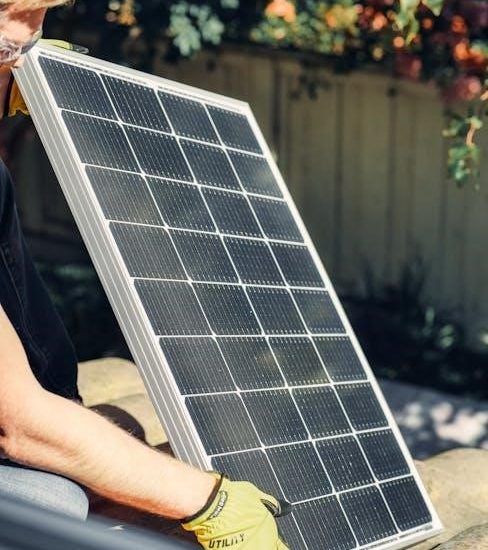A solar panel wiring diagram is a detailed visual guide illustrating the connections between solar panels, batteries, inverters, and other system components. It ensures safe and efficient energy flow, helping users understand how to configure their solar power setup correctly. Whether for residential, RV, or campervan use, these diagrams are essential for proper installation and troubleshooting, providing a clear roadmap for achieving optimal system performance.
What is a Solar Panel Wiring Diagram?
A solar panel wiring diagram is a visual guide that illustrates the connections between solar panels, batteries, inverters, and other components in a solar power system. It provides a detailed layout of how energy flows from the panels to the battery bank and inverter, ensuring proper installation and troubleshooting. These diagrams are essential for configuring systems correctly, whether for residential, RV, or campervan use, and help users achieve optimal performance while maintaining safety and efficiency.
Importance of Understanding Solar Panel Wiring
Understanding solar panel wiring is crucial for ensuring safety, efficiency, and reliability in solar power systems. Proper wiring prevents electrical hazards, optimizes energy flow, and safeguards components from damage. It helps users troubleshoot issues, maintain system performance, and avoid common pitfalls like short circuits or voltage drop. Knowledge of wiring diagrams enables effective installation, customization, and upgrades, ensuring the system operates at its best capacity while adhering to electrical standards and safety protocols.

Components of a Solar Panel System
A solar panel system typically includes photovoltaic (PV) panels, a charge controller, battery bank, inverter, and mounting hardware. These components work together to generate, store, and distribute renewable energy efficiently.
Solar Panels
Solar panels are the heart of any photovoltaic system, converting sunlight into electrical energy through photovoltaic cells. They are typically wired in series or parallel to achieve desired voltage and current levels. Proper orientation and mounting are crucial for maximizing energy production. Panels are connected using MC4 connectors, ensuring secure and weatherproof connections. Their efficiency and durability make them a cornerstone of renewable energy systems, providing a reliable power source for homes and vehicles.
Charge Controller
A charge controller regulates the flow of energy from solar panels to the battery bank, preventing overcharging and ensuring optimal charging. It protects the system by monitoring voltage and current levels. Available in MPPT (Maximum Power Point Tracking) and PWM (Pulse Width Modulation) types, it maximizes energy efficiency and safeguards against overvoltage. Properly connected in the wiring diagram, it ensures reliable energy storage and system protection, making it a critical component for maintaining battery health and overall system performance.
Battery Bank
The battery bank stores excess energy generated by solar panels for later use, ensuring a steady power supply during low sunlight or at night. Configured in series or parallel, it matches the system’s voltage and capacity needs. Proper wiring, as shown in the diagram, is crucial for safety and efficiency. Deep-cycle batteries are ideal for solar systems, offering long-term durability and reliable energy storage, making them a vital component for off-grid and hybrid setups.
Inverter
The inverter converts DC power from solar panels or batteries into AC power for household appliances. It is a critical component, ensuring compatibility with electrical devices. String inverters and microinverters are common types, each offering unique benefits. Proper sizing is essential to match the system’s power requirements. The wiring diagram illustrates connections between panels, batteries, and the inverter, emphasizing safety and efficiency. Regular maintenance and correct installation ensure optimal performance and longevity of the solar power system.
Mounting Hardware
Mounting hardware secures solar panels in place, ensuring stability and optimal energy absorption. Components like brackets, clamps, and rails are essential for rooftop or ground-mounted systems. They must be durable to withstand weather conditions and support the panels’ weight. Proper installation involves securing hardware to rooftops or ground frames, aligning panels for maximum sunlight exposure. The wiring diagram highlights how panels connect through these mounts, ensuring a safe and efficient energy flow. Secure fastening and alignment are critical for system longevity and performance.
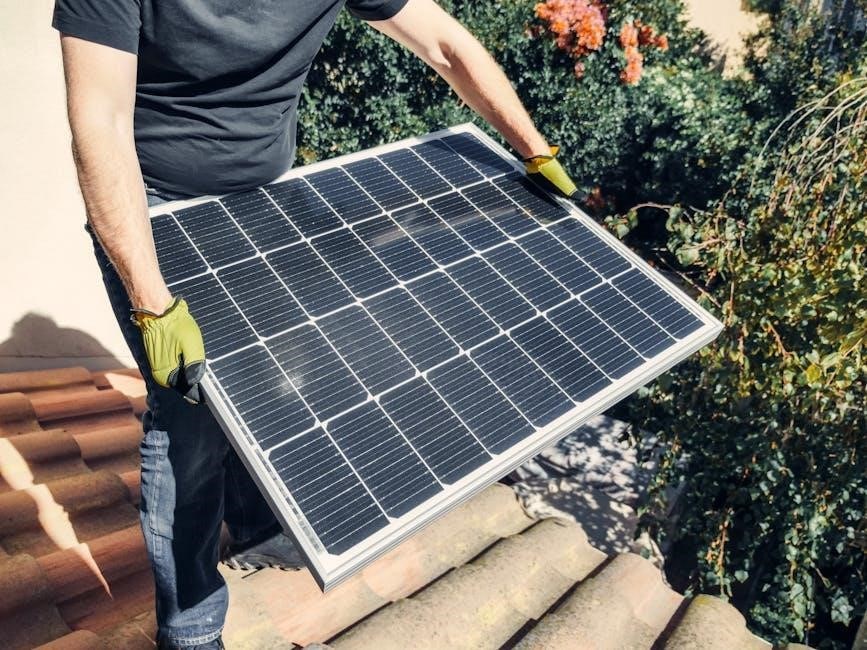
Basic Solar Panel Configurations
Basic solar panel configurations include series, parallel, and series-parallel wiring, each optimizing voltage and current for specific energy needs and system requirements.
Series Wiring
In a series wiring configuration, solar panels are connected end-to-end, increasing the system voltage while maintaining the same current. This setup is ideal for charging higher voltage battery banks, such as 24V or 48V systems. Series wiring is commonly used in RVs or campervans where space is limited, as it allows for fewer connections and simpler wiring. However, it can be less flexible if shading or panel mismatch occurs. Proper planning and sizing are crucial for optimal performance in series configurations.
Parallel Wiring
Parallel wiring connects solar panels side-by-side, combining their current while maintaining the same voltage. This configuration is ideal for increasing energy production and ensuring continuous power supply even if one panel underperforms. Parallel wiring is commonly used in residential systems where multiple panels are needed to meet energy demands. It offers flexibility and redundancy, making it suitable for larger installations. However, it requires careful balancing to avoid energy loss and ensure all panels operate efficiently together.
Series-Parallel Wiring
Series-parallel wiring combines the benefits of both configurations, offering flexibility for systems with specific voltage and current requirements. Panels are initially connected in series to increase voltage, and then these series strings are connected in parallel to boost current. This configuration is ideal for larger systems where voltage and current need to be balanced. It allows for greater scalability and adaptability, making it suitable for complex installations. Proper planning is essential to ensure even energy distribution and minimize losses.
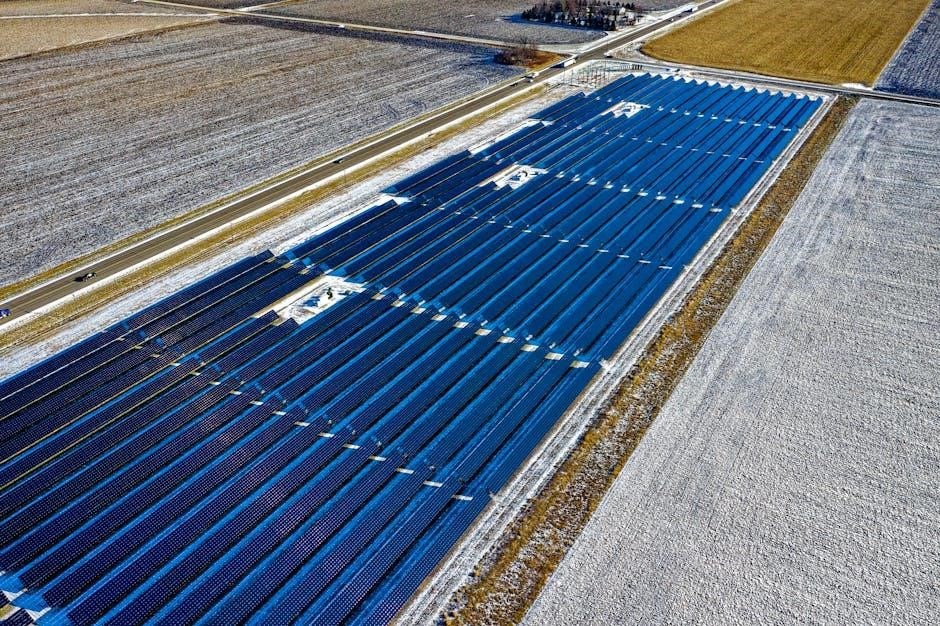
Safety Considerations
Fusing and circuit protection are critical to prevent overcurrent and potential fires. Proper grounding ensures safe operation, while disconnect switches allow for system maintenance and emergencies. Always follow electrical codes and use appropriate protective equipment to minimize risks during installation and operation.
Fusing and Circuit Protection
Fusing and circuit protection are essential to safeguard your solar panel system from overcurrent and potential fires. Correctly sized fuses (e.g., 15A or 20A for PV circuits) ensure protection without unnecessary interruptions. Circuit breakers or fusible disconnects provide an additional layer of safety, allowing for easy system maintenance and emergency shutdowns. Always use components rated for your system’s maximum current to prevent damage and ensure reliable operation. Proper installation of these devices is critical to maintaining safety and efficiency in your solar setup.
Grounding Requirements
Proper grounding is critical for ensuring the safety and efficiency of your solar panel system. Grounding prevents voltage surges and protects against electrical shocks by providing a safe path for current to flow into the earth. All metal components, including panels and mounting hardware, must be grounded to prevent voltage buildup. This ensures compliance with electrical codes and maintains the overall safety of the system. Proper grounding is a key aspect of any solar panel wiring diagram, safeguarding both people and equipment from potential hazards.
Disconnect Switches
Disconnect switches are essential for safely isolating solar panel systems during maintenance or emergencies. They allow you to manually interrupt the electrical flow between components, ensuring no power is present when working on the system. Typically installed between the solar panels and the inverter or battery bank, these switches prevent accidental energy discharge. Proper installation of disconnect switches is crucial for compliance with electrical codes and for ensuring safe operation and servicing of the solar panel system.
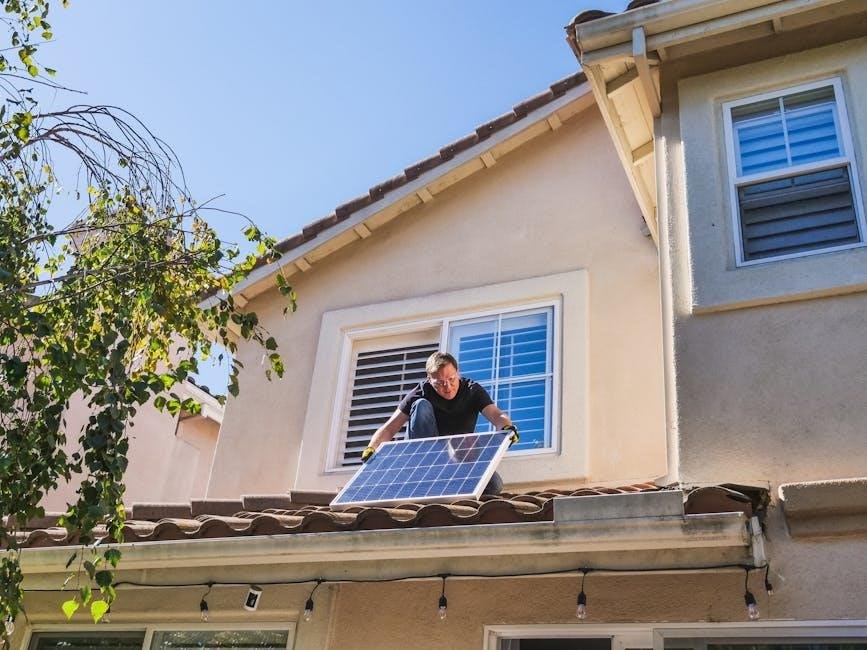
Best Practices for Solar Panel Wiring
Ensure proper wire sizing and use high-quality connectors to minimize voltage drop and prevent overheating. Label and organize wires for clarity and safety, following electrical standards.
Calculating Wire Size
Calculating the correct wire size is crucial for ensuring efficient energy transfer and preventing overheating. Use the NEC 310.15(B)(16) table to determine the appropriate wire gauge based on system voltage and current. Factors such as wire length, temperature, and ambient conditions must be considered. Oversizing wires can increase costs, while undersizing may lead to safety hazards. Always consult local electrical codes and manufacturer guidelines for precise calculations.
Minimizing Voltage Drop
Minimizing voltage drop in solar panel wiring is essential for maintaining system efficiency. Use appropriately sized wires based on the system’s current and voltage to reduce resistance. Shorter wire lengths and higher gauge wires help minimize energy loss. Properly configuring panels in series or parallel can also balance voltage and current effectively. Ensure all connections are secure and use high-quality materials to prevent excessive voltage drop and ensure optimal energy transfer.
Using Proper Connectors
Using proper connectors is crucial for a safe and efficient solar panel wiring system. MC4 connectors are commonly used due to their weather-resistant design and secure locking mechanism. Ensure connectors are compatible with your solar panels, inverters, and other components to maintain optimal performance. Properly sealed connectors prevent water ingress and corrosion, reducing the risk of electrical faults. Always follow manufacturer guidelines for connector installation to ensure reliability and avoid potential system malfunctions or power loss.
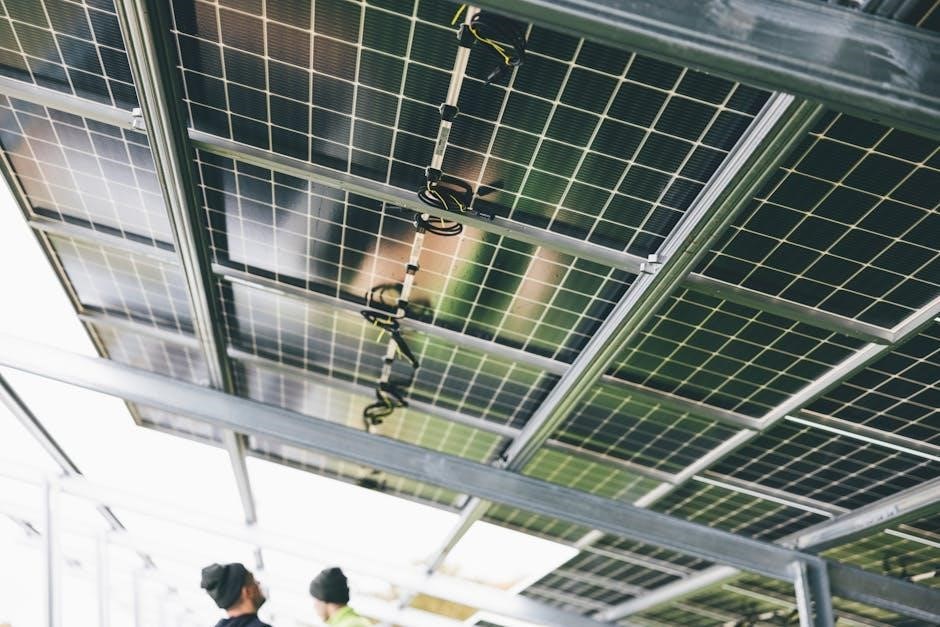
Tools and Materials Needed
Essential tools include a multimeter, wire cutters, and crimpers. Materials needed are solar panels, mounting hardware, connectors, and cables to ensure a secure and efficient installation.
Wire and Cables
Proper wire sizing is crucial for solar systems to minimize voltage drop and ensure efficient energy transfer. Use 10AWG or 12AWG cables for most residential setups, while RV or campervan systems may require smaller gauges. Always opt for UV-resistant, weatherproof wires to withstand outdoor conditions. The wiring should be rated for the system’s maximum voltage and current. Avoid using household wires, as they are not designed for solar applications. Ensure connections are secure and well-insulated to prevent energy loss.
Connectors and Lugs
Connectors and lugs are essential for secure and reliable solar panel connections. MC4 connectors are commonly used for solar panels due to their durability and weatherproof design. Ensure all connectors are rated for the system’s current and voltage. Use high-quality lugs for battery and inverter connections to prevent corrosion and electrical resistance. Properly crimp or solder connections to maintain integrity. Always follow manufacturer guidelines for connector installation to ensure long-term system reliability and safety.
Tools for Installation
Essential tools for solar panel wiring include wire cutters, screwdrivers, multimeters, and crimping tools for secure connections. A multimeter helps measure voltage and current, ensuring system safety. Crimping tools are vital for installing connectors properly. Pliers and wrenches are needed for tightening lugs and connectors. Safety gear like gloves and goggles is crucial during installation. Use a drill for mounting hardware and cable ties for organizing wires. Proper tools ensure a professional and reliable solar panel setup, minimizing risks and ensuring long-term performance.
Calculations for Solar Panel Systems
Calculations for solar panel systems ensure efficient and reliable energy generation. Determine the number of panels, battery capacity, and inverter size to meet energy demands accurately.
Determining the Number of Panels
Determining the number of solar panels requires assessing your energy needs and system voltage. Calculate your total energy consumption in watt-hours daily. Divide this by the panel’s wattage and the number of sunlight hours available. This ensures you select enough panels to meet your energy requirements efficiently. Proper sizing guarantees optimal performance and minimizes energy deficits or excess capacity.
Calculating Battery Capacity
Calculating battery capacity involves determining the total energy your system needs to store. Use your daily energy consumption in watt-hours and divide by the battery’s depth of discharge to avoid over-discharging. Multiply by the number of backup days required to ensure continuous power during outages. This calculation ensures your battery bank is sized correctly, providing reliable energy storage and meeting your system’s demands efficiently without underperformance or premature wear. Proper sizing is vital for optimal functionality and longevity.
Sizing the Inverter
Sizing the inverter is crucial to ensure it can handle the total power output of your solar panel system. The inverter’s capacity must match or exceed the total wattage of your panels and the maximum load it will supply. Calculate the inverter size by considering the total power requirements of your appliances and the surge capacity needed for startup. Choose an inverter rated at least 1.5 to 2 times the total load to accommodate peak demands. Proper sizing ensures efficient energy conversion and reliable system performance. Always consult a professional to avoid undersizing or oversizing the inverter, which can lead to inefficiency or safety hazards.

Troubleshooting Common Issues
Troubleshooting common issues in solar panel systems involves identifying wiring faults, checking voltage and current, and resolving system imbalances. Regular maintenance and diagram reviews ensure reliability and efficiency.
Identifying Wiring Faults
Identifying wiring faults in solar panel systems begins with reviewing the wiring diagram to locate potential issues. Common faults include loose connections, damaged wires, or incorrect panel configurations. Using multimeters to measure voltage and current at key points helps pinpoint mismatches. Short circuits or open circuits can cause system failures. Regular inspections and adherence to safety protocols minimize risks, ensuring reliable energy production and system longevity. Accurate diagnoses are crucial for timely repairs and optimal performance.
Checking Voltage and Current
Checking voltage and current is crucial for ensuring solar panel systems operate efficiently. Use a multimeter to measure voltage at the panels, battery, and inverter. Compare readings with the wiring diagram to verify correctness. Current levels should match system specifications, and voltage drop must be minimized. Mismatches indicate potential issues, such as faulty connections or incorrect configurations. Regular checks help maintain performance, prevent damage, and ensure safe energy flow throughout the system, optimizing overall productivity and reliability.

Resolving System Imbalances
Resolving system imbalances requires identifying and addressing mismatches in voltage, current, or power between components. Refer to the wiring diagram to ensure all connections are correct. Check for loose wires, faulty inverters, or improperly sized components. Reconfiguring panels in series or parallel can restore balance. Monitoring system performance and adjusting settings helps maintain stability. Regular maintenance and timely repairs prevent prolonged inefficiency, ensuring the system operates smoothly and delivers consistent energy output, optimizing overall performance and reliability.
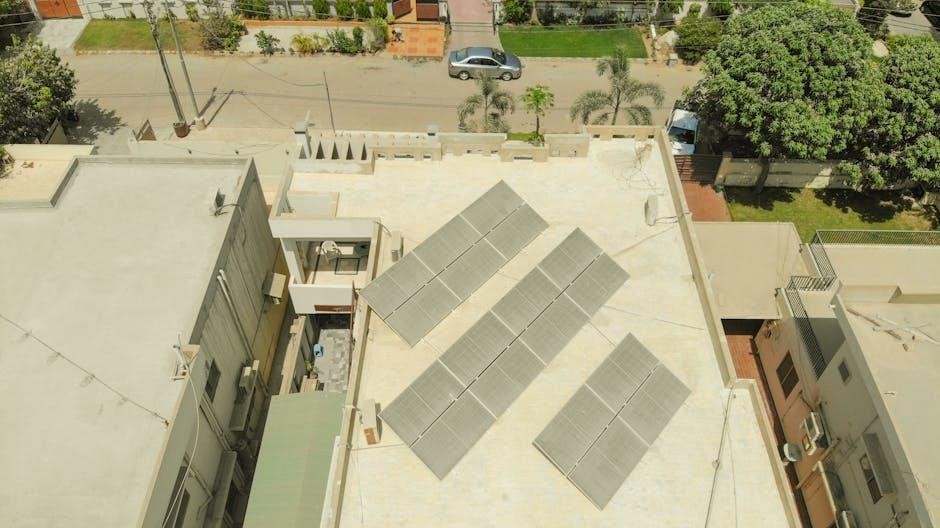
Advanced Configurations
Advanced setups include microinverter systems, string inverters, and hybrid configurations. Microinverters optimize each panel’s performance, while string inverters offer cost efficiency. Hybrid systems combine solar and battery storage for enhanced flexibility.
Microinverter Systems
Microinverter systems use small inverters attached to each solar panel, converting DC power to AC at the panel level. This enhances efficiency and allows individual panel optimization. Unlike traditional string inverters, microinverters enable maximum energy harvest even if one panel underperforms. They also simplify installation and monitoring, reducing the risk of system-wide issues. This configuration is ideal for complex roof layouts or shaded areas, ensuring each panel operates at its peak potential.
String Inverter Configurations
String inverter configurations involve connecting multiple solar panels in series to form a “string,” which is then linked to a single inverter. This setup is cost-effective and straightforward, making it a popular choice for residential and commercial systems. Panels in a string share voltage, simplifying wiring and reducing components. However, shading or issues with one panel can impact the entire string, lowering overall efficiency. Proper sizing and configuration are crucial for optimal performance in this traditional setup.
Hybrid Systems
Hybrid solar systems combine multiple energy sources or storage solutions, such as solar panels, batteries, and grid connections. These systems offer flexibility and reliability, especially in applications where energy demands fluctuate. By integrating energy storage, hybrid setups can optimize power usage and reduce grid dependence. They often include advanced inverters and smart controllers to manage energy flow seamlessly. Hybrid configurations are ideal for locations requiring backup power or off-grid capabilities, ensuring continuous energy availability while maximizing renewable energy utilization. Proper design and configuration are key to their efficiency and performance.
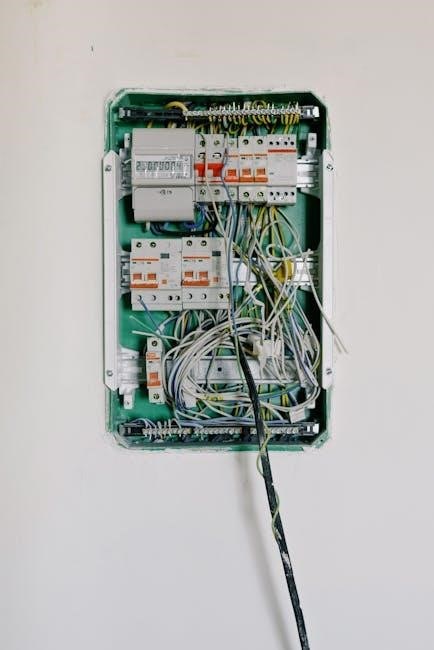
Monitoring and Maintenance
Regular monitoring ensures optimal performance, while maintenance tasks like cleaning panels and checking connections prevent issues. Tools and software help track real-time data, improving efficiency and reliability.
Using Monitoring Systems
Monitoring systems are essential for tracking solar panel performance, ensuring optimal energy production. These tools provide real-time data on voltage, current, and power output, helping identify issues early. Software solutions allow remote monitoring, enabling users to check system status and receive alerts for faults. Regularly reviewing this data helps maintain efficiency and troubleshoot wiring or component issues. Integrating monitoring systems with your solar panel wiring diagram enhances overall system reliability and performance, ensuring long-term energy production.
Regular Maintenance Tasks
Regular maintenance ensures solar panel systems operate efficiently. Clean panels to remove dirt and debris, as this can reduce energy production. Check wiring connections to ensure they are secure and free from damage. Inspect the system for signs of wear or corrosion. Review monitoring data to identify potential issues early. Perform routine checks on inverters and charge controllers. Keep the wiring diagram accessible for quick reference during maintenance tasks. Regular upkeep helps maintain system performance and extends its lifespan.
Updating System Components
Updating system components ensures optimal performance and safety. Regularly check for firmware updates for inverters and charge controllers. Consider upgrading to advanced technologies like microinverters or string inverters for better efficiency. Replace worn-out wiring or connectors to prevent energy loss. When updating, always refer to the solar panel wiring diagram to ensure compatibility and correct installation. Consulting a professional is recommended for complex upgrades to maintain system integrity and performance. Updates help keep the system modern and efficient, ensuring long-term reliability and energy production.
Regulations and Standards
Compliance with electrical codes and international standards is crucial for solar installations. Ensure all components meet safety regulations and obtain necessary permits and inspections to guarantee legal operation.
Compliance with Electrical Codes
Ensuring your solar panel system meets local electrical codes is critical for safety and legality. Compliance involves proper wiring, grounding, and component ratings as per National Electric Code (NEC) standards. Regular inspections by certified authorities are required to validate installations. Using certified components and adhering to labeling requirements ensures system reliability. Failure to comply can result in legal penalties and safety hazards. Always consult local regulations and hire licensed professionals to guarantee adherence to electrical standards.
Permits and Inspections
Obtaining necessary permits and undergoing inspections are crucial steps in solar panel installation. Local authorities issue permits after reviewing system designs, ensuring compliance with electrical codes. Inspections verify proper installation, including wiring, grounding, and component safety. Failure to secure permits or pass inspections can lead to system shutdowns or fines. Scheduling inspections promptly ensures timely project completion and guarantees a safe, code-compliant solar energy system. Always work with licensed professionals to navigate permitting and inspection processes efficiently.
International Standards
International standards for solar panel wiring ensure global compatibility, safety, and efficiency. Organizations like the International Electrotechnical Commission (IEC) and Underwriters Laboratories (UL) set criteria for solar systems. These standards cover wiring, components, and performance metrics, ensuring reliability and environmental compliance. Adhering to these guidelines facilitates seamless integration of solar technologies worldwide. Compliance with international standards also enhances system durability and safety, making solar energy systems more accessible and trustworthy for users across different regions and markets.
Understanding solar panel wiring diagrams is crucial for safe and efficient installations. They provide clear guidance for configuring systems, ensuring optimal performance and compliance with standards. This knowledge empowers users to harness solar energy effectively, while adhering to safety and regulatory requirements. Proper wiring ensures reliability, making solar power a sustainable and accessible energy solution for various applications.
Understanding solar panel wiring diagrams is essential for safe and efficient installations. Key points include recognizing system components, configuring panels in series or parallel, and ensuring proper connections. Electrical principles like voltage, current, and power are critical for optimizing performance. Always follow safety guidelines, such as fusing circuits and grounding systems. Compliance with local codes and using high-quality materials ensures reliability. Regular maintenance and monitoring are vital for long-term efficiency. These principles empower users to harness solar energy effectively and sustainably.
Next Steps for Installation
After understanding the wiring diagram, plan your system configuration based on energy needs and space constraints. Source high-quality components, ensuring compatibility and efficiency. Double-check connections to avoid short circuits or power loss. Install safety devices like fuses and disconnect switches. Consult professionals if unsure about local codes or complex setups. Finally, test the system to ensure proper operation before full deployment. This structured approach guarantees a safe and efficient solar energy setup.

